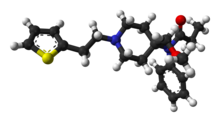Sufentanil
 | |
 | |
| Clinical data | |
|---|---|
| Trade names | Dsuvia, Sufenta, Zalviso, others |
| Other names | R30730 |
| AHFS/Drugs.com | Monograph |
| License data |
|
| Routes of administration | Intravenous therapy (IV), intramuscular injection (IM), subcutaneous injection (SQ), epidural, intrathecal, sublingual |
| ATC code | |
| Legal status | |
| Legal status | |
| Pharmacokinetic data | |
| Bioavailability | 53% (sublingual) |
| Elimination half-life | 162 minutes |
| Duration of action | 30 to 60 min[6] |
| Identifiers | |
| |
| CAS Number | |
| PubChem CID | |
| IUPHAR/BPS | |
| DrugBank | |
| ChemSpider | |
| UNII | |
| KEGG | |
| ChEBI | |
| ChEMBL | |
| CompTox Dashboard (EPA) | |
| ECHA InfoCard | 100.168.858 |
| Chemical and physical data | |
| Formula | C22H30N2O2S |
| Molar mass | 386.55 g·mol−1 |
| 3D model (JSmol) | |
| Melting point | 97 °C (207 °F) |
| |
| |
| (verify) | |
Sufentanil, sold under the brand names Sufenta among others, is a synthetic opioid analgesic drug approximately 5 to 10 times as potent as its parent drug, fentanyl, and 500 to 1,000 times as potent as morphine. Structurally, sufentanil differs from fentanyl through the addition of a methoxymethyl group on the piperidine ring (which increases potency but is believed to reduce duration of action[7]), and the replacement of the phenyl ring by thiophene. Sufentanil first was synthesized at Janssen Pharmaceutica in 1974.[8]
Medical uses
[edit]Sufentanil offers properties of sedation and can be used as analgesic component of anesthetic regimen during an operation.[9]
Because of its extremely high potency, it is often used in surgery and post-operative pain management for patients that are heavily opioid dependent/opioid tolerant because of long term opiate use for chronic pain or illicit opiate use. It is also used in surgery and post-operative pain control in people that are taking high dose buprenorphine for chronic pain because it has the potency and binding affinity strong enough to displace buprenorphine from the opioid receptors in the central nervous system and provide analgesia.[10]
In 2018, the Food and Drug Administration (FDA) approved Dsuvia, a sublingual tablet form of the drug, that was developed in a collaboration between AcelRx Pharmaceuticals and the United States Department of Defense for use in battlefield settings where intravenous (IV) treatments may not be readily available.[11] The decision to approve this new potent synthetic opioid came under criticism from politicians and from the chair of the FDA advisory committee, who fear that the tablets will be easily diverted to the illegal drug market.[12] Dsuvia has since been withdrawn from the market due to "unresolvable manufacturing constraints."[13]
Overdose
[edit]Management
[edit]Because sufentanil is very potent, practitioners must be prepared to reverse the effects of the drug should the patient exhibit symptoms of overdose such as respiratory depression or respiratory arrest. As for all other opioid-based medications, naloxone (trade name Narcan) is the definitive antidote for overdose. Depending on the amount administered, it can reverse the respiratory depression and, if enough is administered, completely reverse the effects of sufentanil.[3]
Society and culture
[edit]Brand names
[edit]Sufentanil is marketed under various brand names including Dsuvia,[14] Dzuveo, Sufenta, and Sufentil.
References
[edit]- ^ "FDA-sourced list of all drugs with black box warnings (Use Download Full Results and View Query links.)". nctr-crs.fda.gov. FDA. Retrieved 22 October 2023.
- ^ Anvisa (31 March 2023). "RDC Nº 784 - Listas de Substâncias Entorpecentes, Psicotrópicas, Precursoras e Outras sob Controle Especial" [Collegiate Board Resolution No. 784 - Lists of Narcotic, Psychotropic, Precursor, and Other Substances under Special Control] (in Brazilian Portuguese). Diário Oficial da União (published 4 April 2023). Archived from the original on 3 August 2023. Retrieved 16 August 2023.
- ^ a b "Sufenta- sufentanil citrate solution". DailyMed. 2 July 2008. Retrieved 13 September 2024.
- ^ "Dsuvia- sufentanil tablet". DailyMed. 18 December 2023. Retrieved 13 September 2024.
- ^ "Dzuveo EPAR". European Medicines Agency (EMA). 25 June 2018. Retrieved 13 September 2024.
- ^ Shaw LM (2001). The clinical toxicology laboratory : contemporary practice of poisoning evaluation. Washington, DC: AACC Press. p. 89. ISBN 9781890883539.
- ^ Vucković S, Prostran M, Ivanović M, Dosen-Mićović Lj, Todorović Z, Nesić Z, et al. (2009). "Fentanyl analogs: structure-activity-relationship study". Curr Med Chem. 16 (9): 2468–2474. doi:10.2174/092986709788682074. PMID 19601792.
- ^ Niemegeers CJ, Schellekens KH, Van Bever WF, Janssen PA (1976). "Sufentanil, a very potent and extremely safe intravenous morphine-like compound in mice, rats and dogs". Arzneimittel-Forschung. 26 (8): 1551–6. PMID 12772.
- ^ Savoia G, Loreto M, Gravino E (September 2001). "Sufentanil: an overview of its use for acute pain management". Minerva Anestesiologica. 67 (9 Suppl 1): 206–216. PMID 11778119.
- ^ "Fentanyl Citrate - Drug Summary". pdr.net. Retrieved 23 October 2015.
- ^ Davio K (5 November 2018). "FDA Approves Painkiller Dsuvia Amid Criticism". American Journal of Managed Care.
- ^ Goodnough A (2 November 2018). "F.D.A. Approves Powerful New Opioid Despite Warnings of Likely Abuse". The New York Times. Retrieved 2 November 2018.
- ^ "https://dsuvia.com/". 4 January 2025. Archived from the original on 4 January 2025.
{{cite web}}: External link in|title= - ^ Silverman E (2 November 2018). "Despite criticism and concerns, FDA approves a new opioid 10 times more powerful than fentanyl". Pharmalot. Retrieved 2 November 2018.
